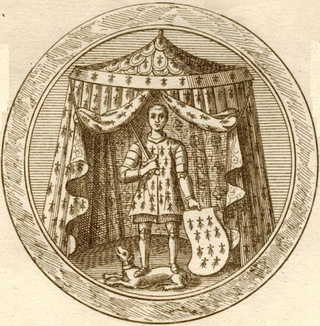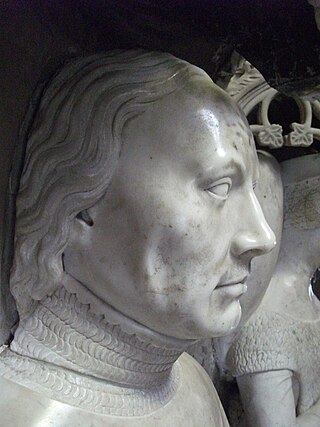
The Battle of Auray took place on 29 September 1364 at the Breton-French town of Auray. This battle was the decisive confrontation of the Breton War of Succession, a part of the Hundred Years' War.

Joan of Penthièvre reigned as Duchess of Brittany together with her husband, Charles of Blois, between 1341 and 1364. Her ducal claims were contested by the House of Montfort, which prevailed only after an extensive civil war, the War of the Breton Succession. After the war, Joan remained titular Duchess of Brittany to her death. She was Countess of Penthièvre in her own right throughout her life.

The War of the Breton Succession was a conflict between the Counts of Blois and the Montforts of Brittany for control of the Sovereign Duchy of Brittany, then a fief of the Kingdom of France. It was fought between 1341 and 12 April 1365. It is also known as the War of the Two Jeannes due to the involvement of two rival duchesses of that name.

John of Montfort, sometimes known as John IV of Brittany, and 6th Earl of Richmond from 1341 to his death. He was the son of Arthur II, Duke of Brittany and his second wife, Yolande de Dreux. He contested the inheritance of the Duchy of Brittany by his niece, Joan of Penthièvre, which led to the War of the Breton Succession, which in turn evolved into being part of the Hundred Years' War between England and France. John's patron in his quest was King Edward III of England. He died in 1345, 19 years before the end of the war, and the victory of his son John IV over Joan of Penthièvre and her husband, Charles of Blois.

Charles of Blois-Châtillon, nicknamed "the Saint", was the legalist Duke of Brittany from 1341 until his death, via his marriage to Joan, Duchess of Brittany and Countess of Penthièvre, holding the title against the claims of John of Montfort. The cause of his possible canonization was the subject of a good deal of political maneuvering on the part of his cousin, Charles V of France, who endorsed it, and his rival, Montfort, who opposed it. The cause fell dormant after Pope Gregory XI left Avignon in 1376, but was revived in 1894. Charles of Blois was beatified in 1904.

John IV the Conqueror KG, was Duke of Brittany and Count of Montfort from 1345 until his death and 7th Earl of Richmond from 1372 until his death.

John V, sometimes numbered as VI, bynamed John the Wise, was Duke of Brittany and Count of Montfort from 1399 to his death. His rule coincided with the height of the Hundred Years' War between England and France. John's reversals in that conflict, as well as in other internal struggles in France, served to strengthen his duchy and to maintain its independence.

Bertrand du Guesclin, nicknamed "The Eagle of Brittany" or "The Black Dog of Brocéliande", was a Breton knight and an important military commander on the French side during the Hundred Years' War. From 1370 to his death, he was Constable of France for King Charles V. Well known for his Fabian strategy, he took part in seven pitched battles and won the five in which he held command.

Olivier V de Clisson, nicknamed "The Butcher", was a Breton soldier, the son of Olivier IV de Clisson. His father had been put to death by the French in 1343 on the suspicion of having willingly given up the city of Vannes to the English.

Lower Brittany denotes the parts of Brittany west of Ploërmel, where the Breton language has been traditionally spoken, and where the culture associated with this language is most prolific. The name is in distinction to Upper Brittany, the eastern part of Brittany, which is of a predominantly Romance culture.

Louis II of Châtillon, son of Guy I, Count of Blois and Margaret of Valois, was count of Blois and lord of Avesnes from 1342 to 1346.

Jean, or Jehan de Beaumanoir, marshal of Brittany for Charles of Blois, and captain of Josselin, is remembered for his share in the famous Combat of the Thirty during the War of Breton Succession (1341–1364) between the warring parties of competing claimants for the Dukedom.

Sir Thomas Dagworth was an English knight and soldier, who led the joint English-Breton armies in Brittany during the Hundred Years' War.

The Battle of Pontvallain, part of the Hundred Years' War, took place in the Sarthe region of north-west France on 4 December 1370, when a French army under Bertrand du Guesclin heavily defeated an English force which had broken away from an army commanded by Sir Robert Knolles. The French numbered 5,200 men, and the English force was approximately the same size.

Jeanne de Clisson, Lady Bentley (1300–1359), also known as Jeanne de Belleville and the Lioness of Brittany, was a French / Breton former noblewoman who became a privateer to avenge her husband after he was executed for treason by the French King Philip VI. She crossed the English Channel targeting French ships and often slaughtering their crew. It was her practice to leave at least one sailor alive to carry her message of vengeance.
Following the defeat of Mauron during the Breton War of Succession, the Franco-Bretons, led by Bertrand Du Guesclin, took their revenge at the Battle of Montmuran on April 10, 1354.
Sir Willian Felton and English knight and seneschal of Poitou. Took part in Battle of Halidon Hill, 1333 and fought at Crecy in 1346. He was appointed lord justice of all the king's lands in Scotland in 1348. He fought at battle of Poitiers in 1356. He was appointed seneschal of Poitou in 1360. He accompanied the Black Prince on the Spanish campaign in 1367 and was called Felleton Guilliam qui ot cœur de lyon by Chandos Herald. He was killed at the battle of Aríñez a skirmish fought by the vanguard of the Black Prince's army.

Amaury IV of Craon, Lord of Craon, Chantocé, Ingrandes, Briollé, Châteauneuf-sur-Sarthe, Précigné and Sablé, Sainte-Maure, Nouâtre, Pressigny and Marcillac, Châteauneuf-sur-Charente and Jarnac, was a French noble, who was part of the Hundred Years' War.

Sir Walter Bentley was an English knight who fought during the Hundred Year's War.

Olivier IV de Clisson (1300–1343), was a Breton Marche Lord and knight who became embroiled in the intrigue of Vannes and was subsequently executed by the King of France for perceived treason. He was the husband of Jeanne de Clisson who eventually became known as the Lioness of Brittany.


















